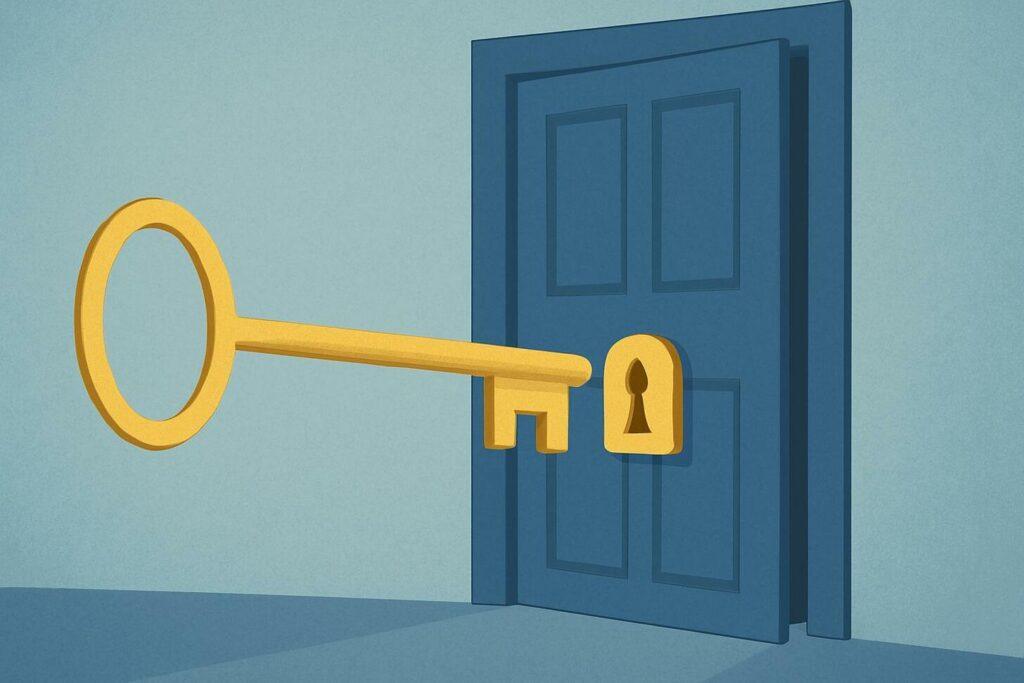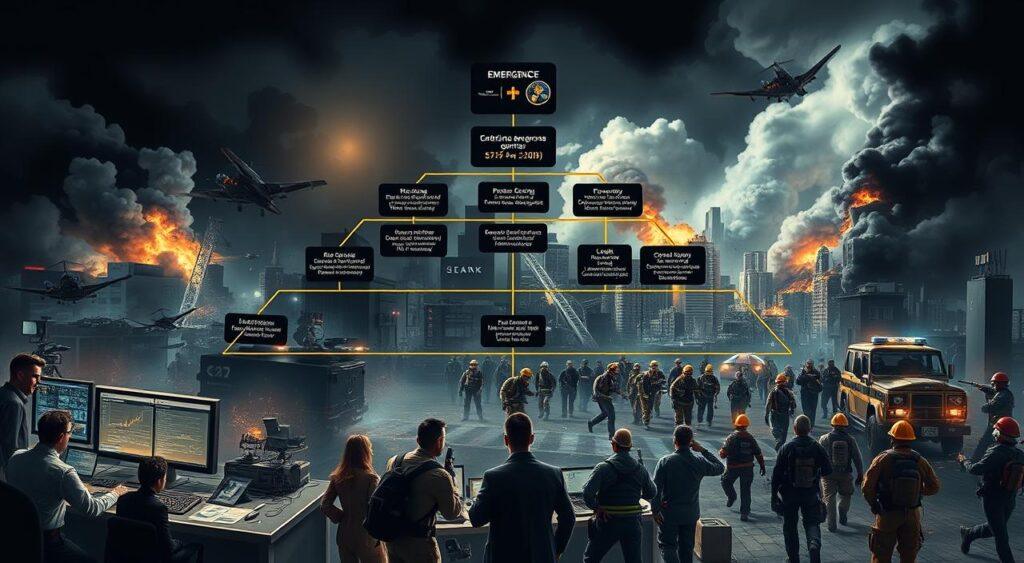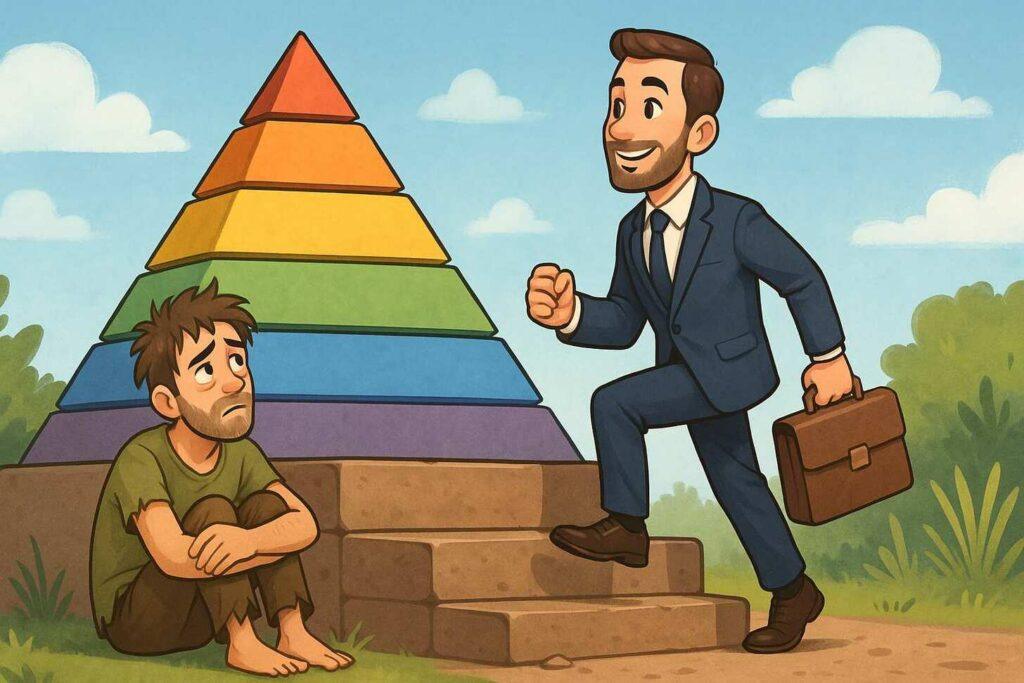Why do some people thrive while others struggle to get by? The key might be the Maslow hierarchy of needs mental model. This framework was created by Abraham Maslow in 1943.
It shows how basic needs like food, safety, and belonging affect our drive and actions.
This model is key in organizational psychology, education, and mental health. It helps us understand why some people reach their full potentials while others stay in survival mode.Why do some people thrive while others struggle with basic motivation?
The answer might lie in the five-tier maslow hierarchy of needs mental model developed decades ago. Abraham Maslow’s pioneering work reveals how human behavior connects to unmet needs – from survival instincts to creative fulfillment.
This theory organizes our priorities like building blocks. Basic requirements like food and safety come first. Only when these are met can we focus on social connections, confidence, and reaching our full potential. Think of it as a roadmap for personal and professional growth.
Today, this concept shapes workplaces, schools, and therapy practices worldwide. Leaders use it to build teams where people feel valued. Parents apply it to nurture resilient children.
You’ll learn how to spot which level someone’s operating from – and practical ways to help them climb higher.
Key Takeaways
- Maslow hierarchy of needs mental model Identifies five interconnected human motivators: survival, security, belonging, esteem, and growth
- Explains why unmet basic needs can block personal or professional progress
- Helps leaders create environments where people naturally excel
- Provides tools to assess motivation levels in yourself and others
- Remains relevant in modern psychology despite being 80 years old
Whether you’re managing a team or pursuing self-improvement, understanding this hierarchy offers surprising clarity.
Let’s explore how a simple pyramid model became humanity’s playbook for meaningful achievement.
How Maslow’s Model Drives Human Motivation

The Maslow hierarchy of needs mental model shows why we act as we do. It starts with basic needs and ends with personal growth. If our basic needs aren’t met, we can’t focus on anything else.
This idea is key in career coaching, helping people recover from trauma, and teaching leaders. It helps find out why we’re stuck and how to move forward.
Science backs up this model. Research shows that feeling unsafe makes our brain go into survival mode. This mode stops us from being creative and solving problems.
Places that meet our basic needs help us achieve more. They create an environment where we can grow and succeed.
Understanding the Foundations: Maslow’s Hierarchy Mental Model Explained
During World War II’s chaos, a psychologist uncovered patterns in human resilience that still shape how we view motivation today. Abraham Maslow noticed people prioritize differently during crises – a revelation that became his life’s work.
Defining the Five Levels of Human Needs
Maslow’s framework starts with physical survival – air, water, food. Next comes safety, then belonging, esteem, and finally self-expression. Each tier builds on the last like steps on a ladder.
Imagine building a house. You wouldn’t install chandeliers before pouring the foundation. This logic explains why aid groups in disasters focus on shelters before therapy programs. Basic requirements anchor progress.
The Historical Context and Development
Maslow began studying motivation in 1943, blending animal behavior research with patient interviews. His 1954 book challenged Freud’s focus on trauma, arguing humans grow toward light when supported.
World War II revealed gaps in existing theories. Soldiers and survivors showed astonishing grit despite trauma. Maslow realized psychology needed a roadmap for potential, not just pathology.
Why does this 80-year-old model still work? It mirrors how kids learn – mastering crawling before sprinting. By addressing core human needs first, we create space for extraordinary growth.
The Maslow Hierarchy of Needs: Unraveling the 5 Levels

What keeps us anchored when life feels unstable? The answer lies in two foundational layers of the Maslow hierarchy of needs that govern our daily choices.
Without these physiological needs, higher aspirations crumble like sandcastles at high tide.
Physiological and Safety Needs as the Base
Our bodies demand attention first. Air, water, and food aren’t preferences – they’re biological imperatives. A dehydrated hiker doesn’t dream of promotions. They fixate on finding water.
Modern life adds layers to these basic needs. Stable housing and healthcare now rank alongside ancient survival instincts. Chronic pain or sleep deprivation? They trap people at this level, as Maslow’s model predicts.
| Need Type | Core Elements | Modern Challenges |
|---|---|---|
| Physiological | Nutrition, sleep, homeostasis | Healthcare access, work-life balance |
| Safety | Job security, financial stability | Gig economy risks, inflation pressures |
Safety needs evolved beyond saber-tooth tigers. Today’s threats include unstable incomes or volatile relationships. A parent working three jobs can’t focus on self-improvement. Their energy goes to protecting what they have.
These layers explain why affordable housing programs boost school performance. When rent worries fade, minds engage better. Stability isn’t luxury – it’s launchpad.
Examples of Needs-Based Decision Making in Daily Life
Imagine someone choosing between college or two jobs to pay rent. Their choice isn’t about dreams, but survival. A teenager skipping meals might only think about making money, not personal growth. This shows how our basic needs influence our decisions, often without us realizing it.
In a study, students with meal stipends were 38% more likely to finish their studies. Once their basic needs were met, they could think about the future. This proves Maslow’s theory works in real life, changing people’s choices and outcomes.
Maslow’s Model Applied in Business and Workplace Motivation
Why do thriving companies invest in both salaries and creative workspaces? The answer lies in understanding how foundational needs, particularly the maslow hierarchy needs, fuel workplace excellence.
When organizations address core requirements, including physiological safety needs, in the right order, employees shift from surviving to innovating.
Employee Satisfaction and Job Security
Research reveals 94% of workers rank job security as vital—a safety need impacting focus. Gallup found teams feeling valued (esteem needs) show 21% higher productivity. Modern HR strategies blend fair pay with psychological safety:
| Need Level | Traditional Approach | Modern Strategy | Impact |
|---|---|---|---|
| Safety | Basic health insurance | Remote work options + emergency funds | 63% lower turnover |
| Esteem | Annual reviews | Peer recognition platforms | 41% engagement boost |
Enhancing Workplace Culture Through Need Fulfillment
Microsoft’s “Growth Mindset” program lets employees design career paths—tapping into self-expression needs. Google’s team-based OKRs build belonging through shared goals. Smart managers ask: “What barriers block this person’s growth?”
Recognition walls in offices spark friendly competition. Training budgets signal investment in potential. When safety and esteem needs get met, teams naturally pursue excellence. Does your workplace free minds—or trap them in survival mode?
From Disaster Zones to Corporate Success

Crises strip away complexity, revealing what truly drives human behavior. When foundations shake, people instinctively focus on essentials first – a pattern mirrored in both disaster zones and boardrooms.
Case Studies on Crisis Response and Aid Prioritization
After Hurricane Katrina, relief groups operated like a triage system. Teams distributed water and blankets before offering trauma counseling. This needs-based order allowed survivors to regain footing – literally and emotionally.
The COVID-19 pandemic became a global case study. Supermarkets saw frenzied purchases of toilet paper and canned goods. Only when shelves stabilized did baking supplies surge – a shift from safety to self-expression needs.
Companies like Airbnb adapted swiftly, highlighting sanitized spaces before promoting social connections.
Research on lockdown behaviors shows similar patterns. Social media use initially dropped 22% as people focused on health updates.
Later, platforms exploded with creative content as isolation intensified belonging needs. These experiences prove that understanding human priorities isn’t just theoretical – it’s a survival skill.
Successful businesses apply these insights daily. A grocery chain during floods stocks batteries and pet food first.
Tech firms during economic downturns emphasize job security before innovation bonuses. Like disaster responders, they recognize which needs demand immediate attention.
How might applying mental models transform your crisis responses? Whether navigating personal storms or market shifts, recognizing foundational needs creates clarity – and often, hope.
Design and Marketing Insights Through Maslow’s Framework
Human connection drives innovation. Brands that solve deeper emotional puzzles create lasting loyalty. This approach reshapes products from mere tools to gateways for self-expression.
Leveraging Belonging for Brand Growth
Airbnb’s early tagline – “Belong Anywhere” – wasn’t about beds. It addressed travelers’ craving for authentic local experiences. This shift from transactional stays to cultural immersion fueled 300% growth in 3 years.
| Brand | Need Addressed | Strategy | Result |
|---|---|---|---|
| Nike | Achievement | Community runs + goal tracking | 22% sales boost |
| Esteem | Skill endorsements | 45% engagement rise |
Social platforms thrive by targeting specific tiers. Instagram feeds creative expression needs with Reels. LinkedIn’s “Open to Work” badges address safety concerns first. Build trust before asking for vulnerability.
Innovative Strategies in Product and Service Design
Apple’s unboxing experience isn’t accidental. The weight of packaging, crisp manuals – every detail whispers “You’re special”. This esteem-building design justifies premium pricing.
| Product | Hierarchy Level | Design Feature |
|---|---|---|
| Peloton | Growth | Leaderboards + live classes |
| Calm App | Safety | Emergency SOS sessions |
Smart companies audit offerings through this lens. Does your checkout process reduce anxiety (safety)? Do testimonials spark belonging? Fix foundations before adding features. What need does your product truly serve?
Scientific Studies and Data Supporting Human Needs Theories

What makes a fulfilled life? Decades of research reveal surprising answers through measurable health outcomes and workplace data. Studies now confirm what psychologists observed – unmet foundational needs create ripple effects across mental and physical well-being.
When Science Meets Survival Priorities
A Yale analysis tracking 7,000 adults found loneliness increases mortality risk more than smoking. Those lacking social connections faced 50% higher early death rates – proof that belonging needs impact biological health. Neuroscience adds clarity: MRI scans show safety threats activate primal brain regions, suppressing creative thinking.
| Study Focus | Key Insight | Real-World Impact |
|---|---|---|
| Harvard Grant Study | Life satisfaction tied to relationships, not wealth | Companies investing in team bonds see 34% retention gains |
| Financial Security Research | $400 emergency lowers IQ by 13 points | Employers offering crisis loans reduce errors by 29% |
| Workplace Safety Analysis | Teams feeling secure attempt 2.7x more innovations | Google’s Project Aristotle linked psychological safety to $9B revenue growth |
Stress from unstable housing or food insecurity triggers cortisol spikes. This hormone flood impairs decision-making – explaining why health outcomes worsen when basic needs go unmet. Yet even critics admit the model’s predictive power: 83% of HR leaders report using need-based strategies successfully.
Peak performance studies mirror these findings. Marathon runners and CEOs alike describe “flow states” matching self-actualization concepts. Though some question the theory’s structure, its practical value in education, healthcare, and business remains undeniable. How might your unmet needs be shaping your daily choices?
Why the Maslow Model Still Matters in 2025

The Maslow hierarchy of needs mental model was created over 80 years ago. It’s key for understanding workplace motivation, product design, and social media habits. Tech companies focus on safety and belonging in their interfaces.
Employers use surveys to predict turnover based on these needs. Coaches help clients find out which tier they’re stuck in. This model is timeless.
A 2023 Deloitte report found companies that meet employee needs have 31% less burnout. Self-help communities also use Maslow’s framework, showing its lasting impact.
Modern Perspectives and Critiques of Maslow’s Theory
How universal are human motivations across cultures? Researchers now question whether one framework fits all societies. While the theory offers valuable insights, modern studies reveal its limitations in diverse contexts.
Debating the Hierarchy’s Rigidity and Cultural Bias
Collectivist cultures often prioritize community bonds over individual achievement. In Japan, team harmony frequently outweighs personal ambitions – a stark contrast to Western self-actualization ideals. This cultural lens reshapes how we apply psychological models globally.
Studies show people frequently address multiple needs simultaneously. A single parent might pursue creative passions (growth) while struggling financially (safety). This fluidity challenges the strict upward progression proposed in traditional hierarchy needs concepts.
| Critique | Example | Alternative Approach |
|---|---|---|
| Cultural Bias | Asian societies value family needs over self-expression | Alderfer’s ERG theory allows concurrent need pursuit |
| Gender Differences | Women often prioritize caregiving over career growth | Life-stage adjusted models |
Modern workplaces use these insights to create flexible development paths. Tech companies like Shopify offer both financial stability programs and innovation grants. This dual approach respects individual circumstances while encouraging growth.
Does your environment recognize different pathways to fulfillment? Understanding these issues helps us support others without imposing rigid expectations. What adjustments could make motivational models work better for your community?
Fulfillment: Implementing the Hierarchy for Growth

What separates those who flourish from those stuck in survival mode? The answer often lies in structured self-awareness, particularly in understanding the maslow hierarchy of needs.
By mapping your current needs, including safety needs, you create stepping stones toward lasting growth – both personally and professionally, fulfilling essential human needs along the way.
Personal Growth and Self-Actualization Strategies
Start with a simple audit: Are basic needs met before chasing creative goals? A teacher I know doubled her writing output after securing childcare. This mirrors research showing stable foundations boost creative risk-taking by 41%.
Build belonging through shared missions. Join groups aligning with your values – whether community gardens or coding meetups. True connections fuel progress. As recent studies note, self-actualized individuals often blend autonomy with collaborative purpose.
Maslow Hierarchy of Needs: Steps for Professional Development
Companies like Patagonia tie job roles to personal values. Employees designing eco-initiatives report 32% higher engagement. Try this: List skills you enjoy using, then seek projects needing those talents.
Create “growth check-ins” quarterly. Track which needs feel met versus neglected. A marketing director I coached shifted from chasing promotions to leading mentorship programs – finding deeper fulfillment through teaching others.
Whether you’re mentoring teams or exploring art classes, remember: Growth isn’t linear. What small step today moves you closer to your fullest potential?
Conclusion
The Maslow hierarchy of needs mental model gives us a simple yet powerful roadmap for understanding motivation and unlocking human potential. Whether you’re leading a team, raising a child, or working on personal goals, this framework shows how unmet needs create invisible roadblocks.
Take time to assess where you are—and what’s next. Small changes can unlock the next tier of growth.
From crisis zones to corporate offices, this model continues to prove its worth across every corner of life. By focusing on foundational needs like safety, belonging, and esteem, individuals and organizations can build environments where creativity and excellence thrive.
As our world becomes more complex and fast-paced, tools like the Maslow hierarchy of needs mental model help cut through the noise. They remind us that growth doesn’t start with ambition—it starts with stability.
Whether you’re rebuilding after setbacks or reaching for new goals, this timeless framework offers clarity, direction, and hope.


